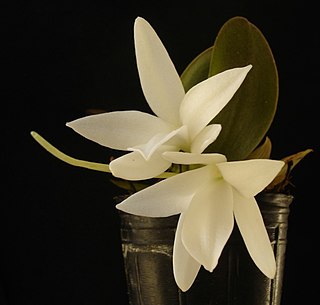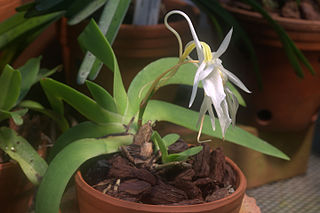
The genus Angraecum, abbreviated as Angcm in horticultural trade, common name Angrek or comet orchid, contains about 220 species.

The Sphingidae are a family of moths (Lepidoptera) called sphinx moths, also colloquially known as hawk moths, with many of their caterpillars known as “hornworms”; it includes about 1,450 species. It is best represented in the tropics, but species are found in every region. They are moderate to large in size and are distinguished among moths for their agile and sustained flying ability, similar enough to that of hummingbirds as to be reliably mistaken for them. Their narrow wings and streamlined abdomens are adaptations for rapid flight. The family was named by French zoologist Pierre André Latreille in 1802.

Louis-Marie Aubert du Petit-Thouars was an eminent French botanist known for his work collecting and describing orchids from the three islands of Madagascar, Mauritius and Réunion. The standard author abbreviation Thouars is used to indicate this person as the author when citing a botanical name.

Amesiella is a genus of orchids endemic to the Island of Luzon, in the Philippines.
Angraecum pyriforme is a species of plant in the family Orchidaceae. It is found in western tropical Africa, to be precise in Cameroon, Ivory Coast, and Nigeria. Its natural habitat is subtropical or tropical moist montane forests. It is threatened by habitat loss.

Angraecum sanfordii is a species of plant in the family Orchidaceae. It is endemic to Cameroon, where it occurs on Mount Kupe and Mount Cameroon. It grows in submontane and montane habitat types. It is an epiphyte. It is threatened by habitat loss.

Angraecum sesquipedale, also known as Darwin's orchid, Christmas orchid, Star of Bethlehem orchid, and king of the angraecums, is an epiphytic orchid in the genus Angraecum endemic to Madagascar. The orchid was first discovered by the French botanist Louis-Marie Aubert du Petit-Thouars in 1798, but was not described until 1822. It is noteworthy for its long spur and its association with the naturalist Charles Darwin, who surmised that the flower was pollinated by a then undiscovered moth with a proboscis whose length was unprecedented at the time. His prediction had gone unverified until 21 years after his death, when the moth was discovered and his conjecture vindicated. The story of its postulated pollinator has come to be seen as one of the celebrated predictions of the theory of evolution.

Aerangis fastuosa, commonly known as the 'magnificent Aerangis', is a species of epiphytic orchid endemic to Madagascar. It is widespread across Madagascar, stretching from the eastern coastal forests across to the south and along the central plateau. Aerangis fastuosa belongs to the family Orchidaceae, substribe Aerangidinae.

Aerangis luteoalba is a species of epiphytic orchid native to eastern and central Africa. This species includes 2 currently recognized varieties:

Angraecum birrimense is a species of orchid, found in Ghana, Ivory Coast, Liberia, Nigeria, Sierra Leone, Cameroon and Zimbabwe.

Angraecum didieri is a species of flowering plant in the Orchidaceae family.

Angraecum leonis is a species of flowering plant in the Orchidaceae family. The orchid propagated around 1922 by Ms. Edith Watson of Home Farm, Woburn, England.

Angraecinae is a subtribe in the family Orchidaceae. The subtribe consists of approximately 18 genera and about 360 species. The type genus is Angraecum. Most of the genera are endemic to Africa, Madagascar and other Indian Ocean Islands, a few genera can also be found in the Americas.
Life form is an entity that is living, such as plants (flora) and animals (fauna). It is estimated that more than 99% of all species that ever existed on Earth, amounting to over five billion species, are extinct.
Cyathochaeta equitans is a sedge of the family Cyperaceae that is native to Australia.

Gilbertiodendron dewevrei is a species of tree in the family Fabaceae, native to tropical rain forests in Central Africa. It is often the dominant tree species of the Guineo-Congolian rainforest. The timber is traded as limbali, and is used for construction, flooring and railway sleepers. It is also used for making boats, furniture, tool handles and joinery and for making charcoal.

Convolvulus equitans, commonly known as Texas bindweed, is a species of morning glory. It is native to the central and western United States and Mexico.

Convolvulus simulans is a species of annual plant in the morning glory family known as the small-flowered morning-glory and small-flowered bindweed. It is an inconspicuous vining plant that is characterized by tiny pale pink or pale blue bell-shaped flowers. It is typically restricted to clay and serpentine substrates in annual grassland, coastal sage scrub and chaparral habitats. This species is native to Arizona, California, and Baja California. Some taxonomies place this species under Convolvulus equitans.














